  |
Design Gumbo
IDSA National Education Conference
September 18-20, 2000
Lafayette, Louisiana
www.idsa.org
Conference Review by core-e-spondent Bruce M. Tharp |
 |
Greetings from Lafayette Louisiana!
In case you're wondering where Lafayette is in relation to New Orleans,
home of this year's IDSA National Conference (you would think more
of us non-southerners at the Educator's Conference would
have thought about this before our flights landed in New Orleans): it's almost
two-and-a-half hours east-not exactly a cheap taxi ride.
We were sure the
National Conference and the Educator's Conference are always in the same city. At any rate, we got a good look at those
miles and miles of Louisiana swampland. |
| Sweet tree, huh? This year's conference was held at the University of Louisiana, Lafayette, in their Alumni House and conference center. I decided to present this year's conference overview much in the same way information was presented there--in slide show/PowerPoint form. If you have been to an academic conference before you know that it is basically a bunch of papers that educators from across the country (and around the world--thanks for playing, Taiwan, UK, and Canada) have written, and that were selected for presentation. And, PowerPoint is the medium of choice (although there were some hard core Luddites who still prefer the old slide projector). |
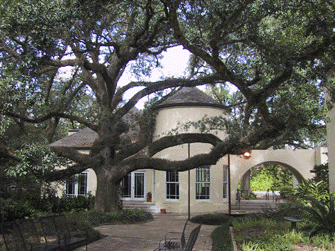 |
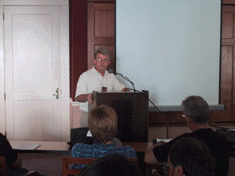 |
IDSA Education Committee Chair, Ron Kemnitzer, opened things up with the annual State of Education Report. While things in academia are generally fine, the big problem is a shortage of college design professors. Yes, that's right. Unlike almost every other academic field, which has a long line of Ph.D.s groveling for meager teaching salaries, Industrial Design has unfilled positions nationwide. So, if you want to teach, the market is yours--think about it, summers off-the glory days of those beach summers don't have to be distant history after all. rbk@kemnitzerdesign.com
|
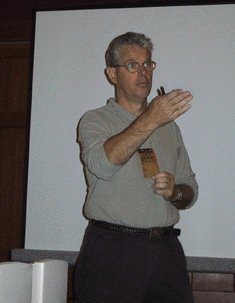 |
Ron Kemnitzer's reign as Education Chair will be over soon and election "speeches" were given by this year's candidates: Ed Dorsa (Virginia Polytechnic Institute and State University) and Jim Kaufman (Ohio State University). Here, Ed addresses comments from the audience on his campaign platform that emphasizes the annual educator's conference. Unfortunately I did not get a shot of Jim, but that should not be interpreted as biased reporting in support of my own agenda, so much as a flash problem with my camera. Oh, and Ed later on presented "Industrial Design: A Great Leap Forward?" which questions emotionally the value that industrial design adds (or is perceived to add) to consumer life in light of its current popularity. dorsa@vt/edu |
| Ahh, industrial design at its finest: the giant inflatable tabasco bottle--global products with a local flavor. If you were not aware, the McIlhenny Tabasco Company is located on Avery Island, about half-an-hour southeast of Lafayette. Their one factory makes the world's supply of tabasco, and undoubtedly their gift shop sells the greatest assortment of hot sauce related gadgets, gizmos, and gee-gaws: including the hot pepper shaped male underpants (use your imagination). More photos from the factory later. http://www.TABASCO.com/cgi-bin/historian.pl |
 |
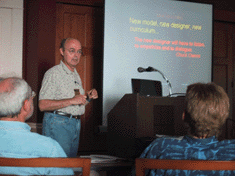 |
The always engaging Jacques Giard, Ph.D. (Arizona State University). Jacques presented two papers: "Education: Beyond an Agenda of Visual Aesthetics" and "Industrial Design Values: focus on the toast, not the toaster." The first "proposes a framework for a vision for an operational model for industrial design education" that departs from those used in art and architecture. The other paper outlines the visual legacy of industrial design, and points toward more appropriate values for industrial design today's specifically environmental concerns and universal design.
|
Neal Moore (Jump Associates of San Francisco), one of a growing number of ID practitioners to attend the conference, presented: "Turning Designers into First-Time Teachers." Based on Neal's own experience as a designer entering the teaching world, he outlines a comprehensible system for classroom pedagogy based upon a product design process.
|
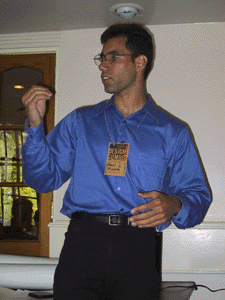 |
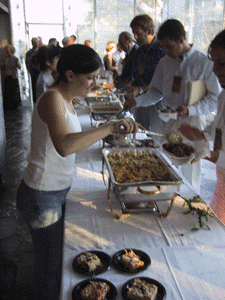 |
Some fine southern vittles prepared and served by undergraduate ID students from UL-Lafayette. No doubt, taking mental note on strategies for superior spatula and ladle designs. |
| While my photography of Esther Ratner (Arizona State University) sucks, her presentation was exceptional. She presented "The Animate Object Theory: blurring the distinction between thing and being," which was selected as one of the top two papers at the conference, and was presented later at the national conference in New Orleans. Postulates of her engaging and well-supported theory are: 1) all objects are animate (i.e., dynamic, living, and/or endowed with a soul/spirit), 2) some objects are more animate than others, 3) designers can influence how animate an object is, and 4) increasing an object’s dynamic/life/soul characteristics is a good thing. <esther.ratner@asu.edu> |
 |
| Yet another crappy photograph of a great presentation. Lois Diane Frankel (Carleton University, Canada) was the other winner of the "best two papers" award. Hers, entitled "Integrating User Interaction Design Processes into the Industrial Design Curriculum," was a wonderfully presented practical guide to incorporating some of the tenets of User Interaction (UI) into ID projects to produce successful interactive products. lfrankel@ccs.carleton.ca> |
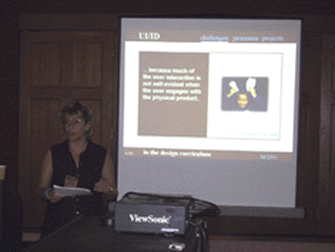 |
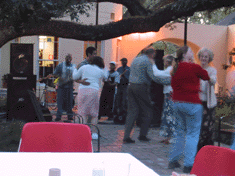 |
So who said that design educators can't get jiggy? Here, a local Creole band plays some traditional southern tunes for our enjoyment. |
Overcoming an audio-visual problem, here Brian Dougan (Louisiana University, Lafayette) uses his tangerine iBook to discuss "A Designer's Rendezvous with Cultural/Social Objects." Brian's thoughtful, provocative, and unique perspective on the art of artifact creation and its location in the university as an act of education, emphasizes the responsibility of the teacher in "sustaining a tangible relation to a meaningful life."
|
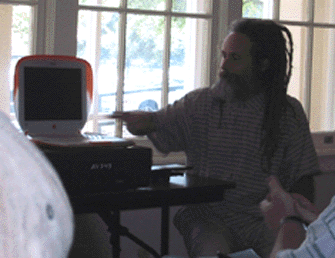 |
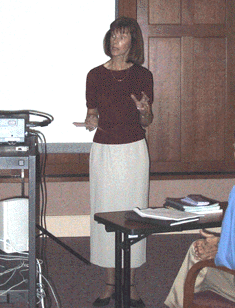 |
Brigitte Valessey, Ph.D. (International Technology Education Association) is the current director of the Center to Advance the Teaching of Technology / Science. Here she speaks of the initiative geared toward integrating design and technology standards into and along the entire education process from kindergarten through 12th grade. http://www.iteawww.org |
| As promised, the outside of the Tabasco factory and administrative building on Avery Island, Louisiana. Not exactly Detroit, eh? |
 |
OK, so after a walk around the side of the factory Mace-like fumes overwhelmed me as I watched this forklift dump barrel after barrel of a thick red pepper concoction into the back of this truck. Seemed a bit unsanitary to me, but then again, most of this stuff just ends up in Bloody Marys.
|
 |
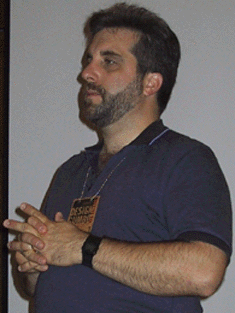 |
Dave Middleton (Western Michigan University) leads a wrap-up discussion, "What is Success?" Somewhat off the topic, suggestions arose about an additional forum for design education ideas. Dave volunteered to investigate and potentially edit a journal for design education. Stay tuned. <david.middleton@wmich.edu> |
| A good ol' southern jazz band plays atop the rooftop of the architecture building at UL-Lafayette during the opening of a design exhibition. |
 |
 |
Think3, maker of some serious 3-D design software, sent representatives to the conference to talk up their goods. Part of their package is that students get their software for free! Check 'em out at http://www.think3.com/education/thinkstart/. |
| Mmmmmm: Po' Boys--a local delicacy. What we have here is basically a fried shrimp sandwich with some spicy Cajun seasoning. Hits the spot, especially after a hard day of welding--which apparently is the occupation of half the population of Lafayette. |
 |
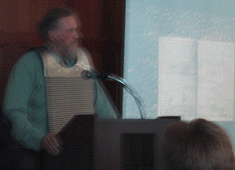 |
Jerry Malinowski (Director, School of Architecture, University of Louisiana, Lafayette) dons a frattoir, the visual icon of the region, as well as a Cajun and Zydeco musical instrument. Evolving from the washboard, it is a percussive instrument that the musician wears--a little like chest armor. Jerry discussed the design history of the frattoir and introduced us to a musician who demonstrated its musical virtues. The demonstration was pretty rocking, to say the least, as evidenced by the vibrations on the image in the camera! |
The other half of Think3's dynamic duo. This Italian software designer amazed the audience with the voice recognition system of their new 3D-design software. It uses some new Microsoft technology that cancels out background noise. Pretty amazing stuff--a taste of the future and the way we will all be CADing and CAMing some day.
|
 |
 |
Ben Pratt (University of Wisconsin-Stout), Lisa Perrine (Cranbrook Academy of Art), and Neil Moore enjoy some po' boys and beers before a night on the town. |
Speaking of night on the town: this is a shot of some of the Lafayette nightlife.
|
 |
 |
Paul Rothstein (Arizona State University), champion of "user-centered design," presents "The Challenge of Understanding and Designing User Experience." Paul outlined a methodology that was recently implemented in a design development workshop and showed that "ethnography provides exactly the type of understanding about human experience that is required to guide and, indeed, animate compelling user-centered design scenarios." paul.rothstein@asu.edu |
| Jim Budd (Georgia Institute of Technology) presents "Digital Literacy for Industrial Designers," which proposes a curriculum that integrates computer software systems that are normally organized by areas of specialty like mechanical engineering, graphic design, drafting, and computer art. Jim discusses the successes of implementation of a sophomore level two-course lecture/lab sequence. |
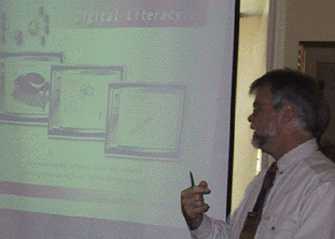 |
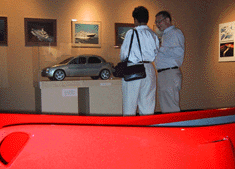 |
Bill Green (Virginia Polytechnic Institute) discusses design virtues at a design exhibition at UL-Lafayette. The big red thing in the foreground is one of the many bobsleds that were designed by Jerry Malinowski (UL-Lafayette) for the US Olympic bobsled team.
|
| Craig Vogel (Carnegie Mellon University) presents "Understanding Perceptual gaps in Value and Part Complexity across Integrated Design Teams." This was based on a Carnegie Mellon study of teams of designers, engineers, marketers, and suppliers at a major automotive company, and resulted in an "understanding how interdisciplinary design teams interact and where conflict begins to arise." CV2G@andrewcmu.edu |
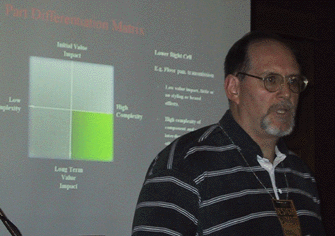 |
 |
Here the author, me, contemplates whether he should write the conference summary article for the Core 77 website before or after more of the local libations. He chose after, which could explain a lot. If you are interested in IDSA or the 2001 Educator's Conference (in Boston, most likely), go to the IDSA website, http://www.idsa.org. Questions and general complaints about this article can be addressed to Bruce M. Tharp at b-tharp@uchicago.edu
|
Bruce M. Tharp, when not working as a core-e-spondent, is presently completing a Ph.D. in Sociocultural Anthropology at the University of Chicago. He holds a Bachelors degree in Mechanical Engineering, and Masters degrees in Industrial Design and Anthropology. His current research falls under the rubric of Material Culture and Consumption. He is interested in commodities within a social contexts (after they have left the control of the designer and manufacturer). More specifically, he researches how individual and collective identities are formed through consumption, and concomitantly, how asceticism and decisions not to consume help in the construction of self.
He may be reached at b-tharp@uchicago.edu |